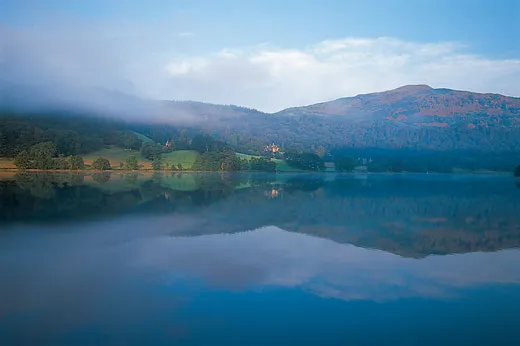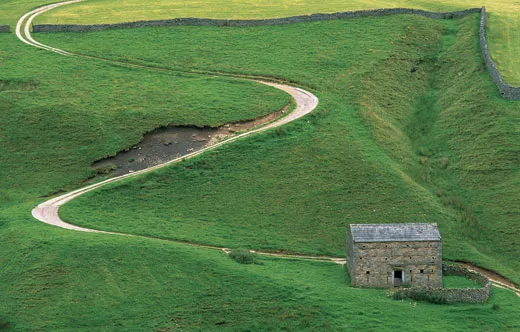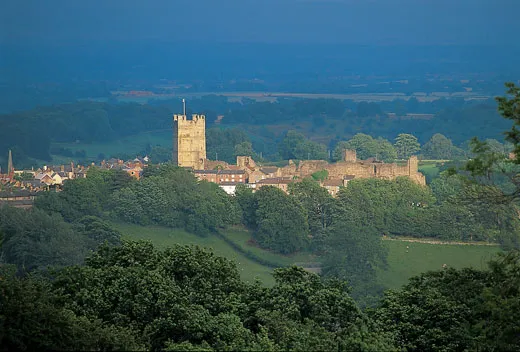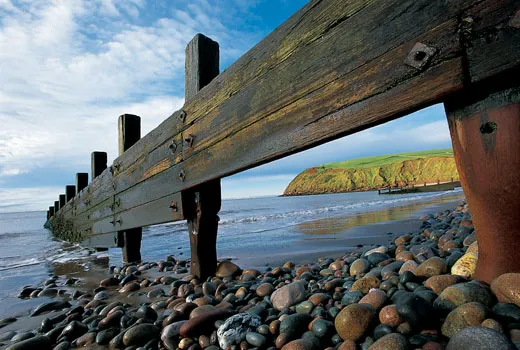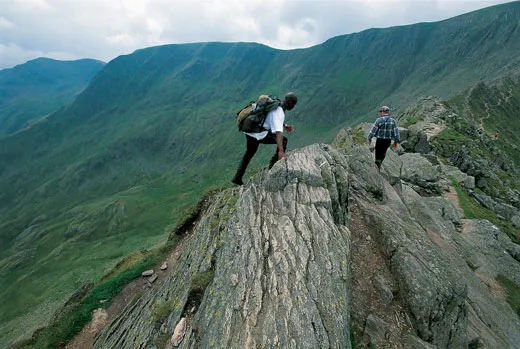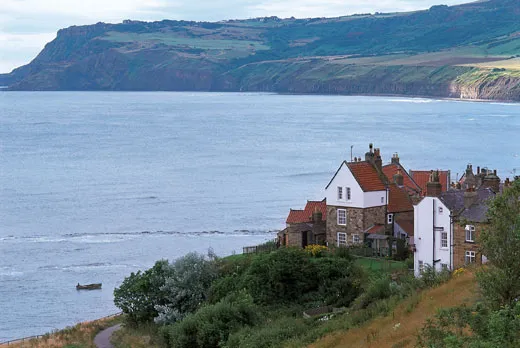A Walk Across England
In the 1970s, British accountant Alfred Wainwright linked back roads, rights-of-way and ancient footpaths to blaze a trail across the sceptered isle
When an English accountant named Alfred Wainwright first went to the lonely hills of northern England in 1930, he was a lonely man. But the cool, empty vistas of moor and mountain must have soaked up his own emptiness like a sponge, because the hills were where he found love.
Today, many people walk in the footsteps of Alfred Wainwright, whose passion for the mountains turned him from accountant into author. The reason is simple: Wainwright, who died at age 84 in 1991, wrote a series of guidebooks to walks through the wildest landscapes in Britain. One book in particular created a now-famous route through heather and woods, over stiles, past lakes, among sheep and across ridges in the face of horizontal rain, from one coast of England to the other.
The route is called the Coast to Coast. It's a walk through history and time, across an England that seems not to have changed in hundreds of years. But the trip is also a journey of companionship, and the most familiar friend is Wainwright himself, who walked alone.
Recently, my wife, Suzanne, and I decided to follow in his footsteps. As it was for Wainwright, it was a map that first intrigued us. "Give me a map of country I do not know," he wrote, "and it has the power to thrill and excite me."
The maps he made of the Coast to Coast walk are wonderfully appealing, with intricate dotted route and contour lines, bushy marks for bogs, notes for gates and barns, alternate routes to mountains (called fells), and drawings of outcrops, tarns (lakes) and waterfalls. Wainwright said he began making maps so that by looking at them, he could "go on fell walking in spirit long after my legs had given up." He didn't know that it would not be his legs that would betray him in the end, but his eyes.
As we looked at the maps at home, they showed a long wriggle of a route, starting in northwest England at the village of St. Bees on the Irish Sea and leading out into delightful imaginary distances, through three of Britain's finest national parks, to the village of Robin Hood's Bay, 190 miles away on the North Sea. But at the start of our walk, on a cool morning under a gathering overcast, the maps suddenly turned real and the distances long.
We began, as most walkers do, in St. Bees. We had been planning the trip for more than a year, delayed by the scourge of foot-and-mouth disease, which roared like wildfire through this part of Britain, closing trails and leaving farm and tourist economies in shambles. But now the fields were clean and the gates were open. We stood on an expanse of low-tide beach and, as Coast to Coast tradition demands, let gentle little Irish Sea waves wet the soles of our boots.
After a magnificent first five miles along sea cliffs, among sounds of waves and gulls, we walked up a quiet lane into the village of Sandwith. It was like many of the villages we would soon encounter: a cluster of white cottages, two pubs, a patch of green with a picnic table, and a farm road leading east. It felt as if we had already shed the hasty part of time and were immersed in Britain's ancient, slower flow of days and hours in which all travel moved at the pace of feet or hooves, and the space between villages was set by the distance a person could walk in a day.
"Coast to coast, are ye?" said an elderly man with a cane and a collie as we walked into Sandwith. "Going to do it all?"
"Yes," we answered.
"Oh," he said, shaking his head. "You'll be tired." He reached into his pocket and gave us a roll of mints.
Both sobered and fortified, we set off toward green hillsides, now shrouded in rain, and started uphill. Soon it became steep and slippery. "Never believe Wainwright when he says ‘gentle climb,' " another walker wrote in a guest book we saw later in a hotel in Robin Hood's Bay.
Alfred Wainwright's vocation perhaps explains the tidiness of his many guidebooks and his occasional grim understatement. He was born in 1907 and raised in the gritty textile city of Blackburn, northwest of Manchester. In 1931 he married a woman named Ruth Holden, who worked in a textile mill. They had a son, whom they named Peter, but the couple had little in common, and they soon ran out of even friendship. "He had ruined her life," Wainwright wrote in a short story that was clearly autobiographical, "just as surely as he had ruined his own." A.W., as he preferred to be called, began to indulge in dreams of one day finding a different—and perfect—female companion he termed "she whom he loved." But the romance he found was with a place, and it was decidedly not comfortable: the mountainous north of England.
On the ascent from the west, A.W.'s guidebook told us as our pace slowed in the first climb, "it is the sudden revelation of the Lakeland fells that rivets the attention." For him the introduction to the Lake District, when he came here for a week's holiday in 1930, riveted his whole life to the fells. "I saw mountain ranges," he wrote, "one after another, the nearer starkly etched, those beyond fading into the blue distance. Rich woodlands, emerald pastures and the shimmering waters of the lake below added to a pageant of loveliness. . . . "
For us the pageant of the first park, Lake DistrictNational Park, was limited and wet. We had walked into what a 60-ish, shirtless British hiker later told us was "a bit of heavy dew." In other words, ropes of rain.
We wore full rain gear, but as the shirtless Brit might have said, we were nevertheless a bit damp when we climbed a sodden hillside after a walk of 131/2 miles and arrived at a bedand-breakfast called Low Cock How Farm. A long white building with a dripping slate roof and four tractors in the front yard, the establishment was pleasantly crowded with 11 other equally wet walkers. Their clothing and ours soon festooned the place, hanging from nails in beams near the fireplace. But the baths were enormous, the hot water abundant and the company congenial. In one of the bathrooms we found a bottle labeled "M-RMuscle Embrocation. Ideal for Horses and Dogs." It was nearly empty.
In the morning, we partook of a vast English breakfast of cereal, eggs, bacon, broiled tomatoes, beans, toast and marmalade—a breakfast that would be presented at every B & B—then set off again. The previous day's rain had seemed geological, something so massive and permanent it would require an earthquake to dislodge, but as the morning progressed, the sun roared like a British lion and dispersed the clouds in fleeing shreds. Now we stepped full-on into the pageant.
Both sky and land were tumultuous. As we walked out of a forest, dark mountains rose and silver water fell, mixing white sound with the wind. The first lake of many, Ennerdale Water, stretched out before us, a blue pool under the treeless slate-and-granite ridges of some of the Lake District's more famous mountains: Red Pike, Pillar and Haystacks.
"Lakeland means, to most visitors, not lakes but mountains," A.W. wrote in his Coast to Coast guide. And indeed it is the high country, clothed only in patches of bracken and heather, that gives the whole district its definitive aura of openness and freedom.
The trails of the Coast to Coast run through private land as well as public parks, following back roads, rights-of-way across fields, and ancient footpaths between towns. This access is jealously guarded by several organizations, including the Ramblers' Association, which recently helped push through a national law to open millions of acres to walkers by establishing new rights of access to uncultivated land.
Continuing on, we reached a high slope and looked back along the ridge at the heap of rock called Haystacks. Beneath it was a gleam of water called Innominate Tarn, A.W.'s favorite spot on earth. "Aquiet place, a lonely place," he wrote of the lake. "Where the water gently laps the gravelly shore and the heather blooms and Pillar and Gable keep unfailing watch."
After 21 years working his way up in the ranks at the BlackburnTown Hall, Wainwright followed the lure of the mountains and got out of industrial England. He took an accounting job working for the quiet Lakeland town of Kendal and moved there with his family. Although his marriage was still intact, it was, according to his biographer, Hunter Davies, miserable. But the move was not.
"I am a lover come back to his first and best love, and come to stay," he wrote a friend. "Nobody here knows me, yet I am surrounded with friends: the tall trees by the river, the enchanting path over by the castle, the birds and the squirrels in the wood; and all around me, most faithful and constant of all, the unchanging hills."
As we followed Wainwright's directions over his unchanging hills, we got to know his gruff and idiosyncratic side (the part that fed his curmudgeonly reputation), as well as his often sardonic sense of humor.
This will seem "the dullest section of the walk," Wainwright wrote of a stretch of the route approaching Whitwell Moor. "Those who believe the Earth is flat will be mightily encouraged in this section. . . . Verily a slough of despond." "Before proceeding beyond the tarn," he warned of Lakeland's GrisdalePass, "sit down awhile and consult (a) the weather, (b) the time, (c) the state of the blisters. . . . "
Aye, there's the rub. By the time (three days and 38 miles into the walk) we got to Wordsworth's "dear vale" of Grasmere, the town where the poet lived for 14 years, blisters and knee pains from steep descents had made the journey less enchanting. We each bought blister remedies by the boxload and a pair of lightweight hiking poles and set off again.
We had become part of a small moving community of people who had all started in St. Bees about the same time. It included a group of five superhiker Australian women, who quickly disappeared ahead to be tracked only in B & B guest books; a pair of sweetly happy British honeymooners, who disappeared languidly behind; a New Zealand couple with blisters at least equal to ours; two anonymous women from the Seattle area; Helen and Richard Lupton from British Columbia; Roger and Joanna Garrett from Michigan; and a solitary but gregarious Irishman named Paul. We learned of some members through gossip only. A man from the Netherlands named Piet, quickly nicknamed the Flying Dutchman, passed among us like a ghost, said to be cruising 25 miles a day. We also heard a rumor that somewhere out there were celebrities: two past British tiddlywinks champions.
We were walking ever deeper into British history, surrounded by prehistoric standing stones; Roman forts; names like gill (which means ravine or stream) and fell, both left by the Vikings; and stone fences from the 18th century. A framework of the walker's old-fashioned kind of time settled around us, made of barriers as solid as the fences: limits of distance, stamina, energy, daylight, weather and knowledge of terrain.
In this mood we came upon a long straight path on a ridge. It was the remains of a Roman road now called High Street, which lies along a broad-backed mountain of the same name. The road was probably built in the first century A.D., and even after 2,000 years it retained the authority of empire. We might have imagined joining a clanking company of Roman soldiers, except they'd have shamed us. Their rate of march even in the mountains is said to have been about 18 miles in five hours. We, on the other hand, were hard pressed to go half that speed.
Lakeland let us go brutally, with a steep descent—"hard going," A.W. wrote in his guide—agonizing to knees and blisters. He hinted that mountain lovers might prefer to stay in Lakeland's lofty magnificence "and be damned to the Coast to Coast walk." If you don't continue, he said, "no hard feelings. You'll think of something to tell the folks at home." But, he went on, you "could have regrets. And (let's be clear about this) you can't expect to get your money back for the book."
Set up for scenic anticlimax, we found, instead, that the landscape opened out in the distance toward the magnificent long ridges of the north edge of the YorkshireDalesNational Park. Here, trails and country lanes led between deep green pastures and along streams in the shadows of oak trees, and after the climbs and descents of the mountains, the gentleness of terrain turned us from hikers back into walkers.
The terrain was gentle, but the history was not. The human presence here goes back at least 11,000 years, and the oldest known artifact is a harpoon. Shapes in the hills reveal forts and graves. Power ebbed and flowed through the centuries, from the warlike tribes called the Brigantes, to the Romans who fought them, then later to the Danes and Vikings. When the Normans arrived in 1066, they engaged in what is now described as ethnic cleansing. Later, they gave vast estates to the church, in order, one author writes, to ensure "a safe passage, after a sinful life, to heaven." So wealth and power came to be vested in churchmen, who built farms and estates centered around abbeys.
As we reached the town of Shap after a long day, we passed the ruins of Shap Abbey, which was founded in 1199. The remaining structure stands quietly near a stone bridge, among sheep, its power yielded to a more secular world. The Hermitage B & B, where we stayed the night, is relatively new: the year 1691 was written over the front door. "There is a sense of sanctuary here," said proprietor Jean Jackson, who's seen many "Coasters" stagger to her door. They have impressed her with their, well, individualism. "People are peculiar," she said, "in the nicest ways."
The owners of our next B & B, the Jolly Farmers, in the town of Kirkby Stephen, told us of opening their door, on more than one occasion, to people who immediately burst into tears. I can understand. The leg between Shap and Kirkby Stephen turned out to be a tough 20 miles through a steeply rolling landscape, made more difficult for passing near, but not near enough, a chocolate factory. At least the weather was good; during wet and muddy periods, the proprietors of the Jolly Farmers have been known to stop their guests on the doorstep and hose them down like sheep.
As we moved on from Kirkby Stephen, the miles slipped past more swiftly, just as the years—filled with hikes, work and a tedious marriage—had slipped past Wainwright. Then, in 1952, his life changed. In that year he began a series of seven guidebooks to the fells of Lakeland, drawing each page by hand, including intricate sketches, maps and text. "I don't think anybody since the days of the monks had ever produced a completely handwritten book," his printer told his biographer. A.W. went into debt to publish the first of these, The Eastern Fells, in 1955. By the time the seventh came out in 1966, the series had become a great success. But it wasn't until 1973 that he published A Coast to Coast Walk and, with it, scratched his own signature across Britain.
"A sundial records the hours," says the Coast to Coast guide, "but time is measured in centuries at Keld." For us it had been a short day: 123/4 miles from Kirkby Stephen. In Keld, an ancient little town on a hillside, we met Doreen Whitehead, author of a well-known bed-and-breakfast guide to the walk, who had known Wainwright.
"I think he was a kind man at the bottom of him," she said. "He brought a lot of prosperity to these little villages." A.W. had a reputation for being gruff and abrupt, but Whitehead dissented; he'd always taken the time to talk with her.
The next morning we walked through an extraordinary landscape of ruined stone buildings, torn earth and holes in the ground. These were old lead mines, where, starting in the 16th century, thousands of men had dug out ore until the industry collapsed in the 1880s. Not far from a monumental ruin of a smelting mill called Old Gang, about 15 miles from the city of Richmond, the fabled tiddlywinks champs turned up. They were Alan Dean, wiry and lean, and agile across the hilltops, and Charles Relle, tall and broad, and desperately afraid of heights. Alan and Charles were peculiar in the nicest sort of way. "All tiddlywinks players are odd," Charles said when we had dinner with them a couple of days later. "You're expected to be odd," added Alan.
The notion of serious adult competition in the game of tiddlywinks, which involves flipping coin-size pieces of colored plastic into a small cup, was dreamed up in the mid-1950s by a group of students at Cambridge who wanted to hack into some of the respect given athletes. Now here were two champions from the 1970s tramping the Coast to Coast with a rolled-up tiddlywinks tablecloth, playing a match in a pub every night. We arranged to meet the pair in two days for a game, and with that in mind, Suzanne and I marched off into the longest—and according to A.W., the most boring—day.
"You have heard of Yorkshire's broad acres," he wrote in the Coast to Coast guide. "Here they are in person, interminable. . . . " But we continued to find the route charming, bucolic and friendly. We even enjoyed Danby Wiske, where A.W. vented his spleen at a town he said "is less attractive than its name. . . . You are tired and hungry but nobody wants to know. . . . "
We stopped at the White Swan Inn and pub, all white walls outside and dark wood inside. The proprietor, Frank Phillips, was very familiar with A.W.'s cantankerousness, but forgave him genially. "Wainwright just didn't like the plain between the mountains," he said. "He didn't get a good reception when he got here." Phillips laughed. "Things have changed. I want them to bring the books up to date."
We pushed on. "Left, right, left, right," A.W. writes, testily. "It is better to stick to the road . . . and get on quickly." The route followed country roads more than trails, but often broke away to take rights-of-way through farms. One was a free-range chicken farm, with thousands of the birds hunting avidly through the fields. Right and left, they strutted up to us with an aggressive air, which made me wonder what would happen if one of us tripped and fell. Would they swarm and peck us down to bones in seconds? That's the kind of thing you think about when you're walking 190 miles. You start off seeking a profound awareness of the complexity of life, and what you get is tiddlywinks and killer chickens.
Not that tiddlywinks is a frivolous thing. At least not the way Alan and Charles played it that night in the pub in Ingleby Cross. They spread their cloth on a table, cleared the area of customers and circled around the scattered winks, popping them at each other's colors and finally at the cup in the table's center. Alan was sardonic about what he considered to be his poor play, but Charles sighed deeply at the fate of each shot and agonized over any errors that he made. He won, 5-2.
After Alfred Wainwright retired in early 1967, he became a full-time author, and even overcame his misanthropic nature sufficiently to participate in a BBC-TV series about his walks, which led to a certain fame. He finally divorced in 1968. (His son, Peter, who worked for an oil company in Bahrain, died just a couple of years ago.) And in 1970, he married his dream woman, "she whom he loved." Her name was Betty, and she didn't walk with him much, but she did drive him to the start of the trails.
So the latter parts of Wainwright's life were like the latter parts of our walk: the stresses of the past were gone, and a pleasant period ensued. Of course, our last days, like his, had their difficulties: various pains, occasional difficult climbs and a wild, wicked and ultimately exhilarating storm. We walked along an old railroad embankment on the ridges, clouds scudding close overhead, and leaned sideways against a 40-mile-an-hour breeze, feeling that when we came down off the hill we would find only horse carts in the lanes.
What we found, instead, was Lion Inn. It stood high on a ridge by a paved road, which looked foreign under the early-England sky. But in its pub was a small gathering of our community of Coast to Coasters: the women from Seattle, two men from southern England that we'd met earlier, and the tiddlywink champs. For a few minutes we were a little village unto ourselves, celebrating the proximity of the North Sea, which now seemed so close across the final hills.
The next day we hoofed it hard for 23 miles to the town of Grosmont, and the following day crossed the last 151/2 miles. In late afternoon, 16 days after we began our journey, we walked down a steep cobbled street in Robin Hood's Bay and heard again the sound of waves and gulls.
The North Sea tide was high, and the water was more restless than on the other side of England. It surged hungrily against the cobbles, and a big sign warned: "Extreme danger on this slipway at high tide." Ignoring the sign, we walked into the water and let the North Sea wash our tired legs.
By the end of his life, Wainwright had lost most of his vision and could no longer read or hike. But no matter. "I live in a world of mists," he told the BBC in his final interview, in late 1990, "but by closing my eyes I can see a thousand walks as clearly as when I first walked them."
When A.W. died a month later, in January 1991, his wife and a close friend, following his wishes, took his ashes up to Haystacks, in Lakeland, and spread them near Innominate Tarn, the quiet place, the lonely place.
Wainwright painstakingly wrote many words in his guidebooks about the abiding passion of his life. But as I look back with nostalgia on nearly 200 miles in his good company and in the company of England, a simple note in A Coast to Coast Walk is my favorite: "There will be other years, other visits," A.W. wrote. "The hills will wait."
Getting There
From Manchester International Airport take the train into Manchester Piccadilly Station. Catch a train to Carlisle, and there, switch to another for St. Bees (www.stbees.org.uk). INSIDE TIP: Walk with naught but the shirt on your back: Sherpa (www.sherpa-walking-holidays.co.uk; 44 2085 772717) and other services will carry your bags for you.
FOR INFORMATION: Try Doreen Whitehead's B & B guide ([email protected]; 44 1748 886374) and visit Coast to Coast Guides (www.coasttocoastguides.co.uk) and the Wainwright Society (www.wainwright.org.uk).
